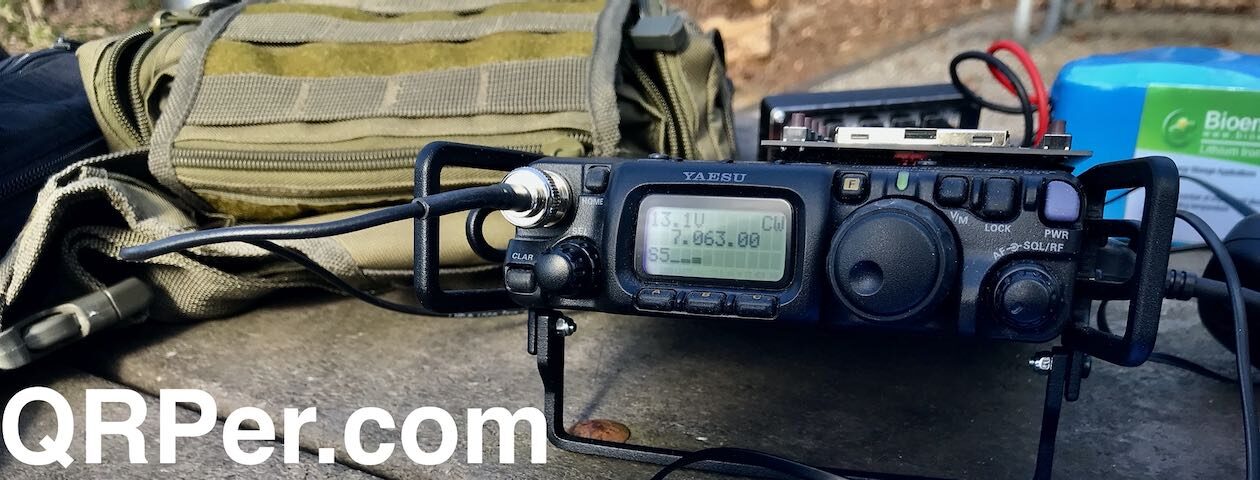Many thanks to Brian (K3ES) who shares the following field report:

A Hike and a 2-fer
by Brian (K3ES)
When you live in northwestern Pennsylvania, and a February day shows up with the sun shining, moderate temperatures, and nothing pressing on the calendar, it is time to go and enjoy the outdoors.
One of the best ways to do that is to take a hike with your dog. Hopefully your dog is like Molly, who doesn’t mind taking a break mid-hike for a Parks on the Air (POTA) activation. So on Wednesday, February 21 we scheduled an activation and jumped in the truck for a drive to the trail head. The hike to and from the activation site would be a nice change from the short walks we had been taking to the pond behind our house in the colder weather, and from activating while sitting in the truck. And, to better share the joy with our POTA hunters, we would make this activation a 2-fer, giving them credit for both the North Country Trail National Scenic Trail (K-4239) and Pennsylvania State Game Land 024 (K-8725).

Since I had hiked the planned route before, both solo, with friends, and with Molly, I expected that the route would be familiar. Some of it was, and some of it was brand new to us. You see, the North Country Trail volunteers had been busy since we last hiked as far up the trail as we planned to go. They had cleared and marked an entirely new route for one section of the trail, bypassing an old favorite activation site! So, we got to do some exploring, and we found a new favorite activation site. Bonus!
Finding a New 2-fer Site
One of the things that I enjoy about POTA is planning my activation.
Since days long ago as a Boy Scout, I have enjoyed outdoor navigation. Map and compass always fascinated me. Things have gotten much easier with Global Positioning System (GPS), online maps, and online satellite imagery. Still, I do most of my activation planning while sitting comfortably at home with a tablet or a computer. For this trip, finding the newly marked trail (that had not yet been transferred to the online map) presented a bit of a challenge. While I could follow the marked trail easily, I needed to be sure that I had entered Game Land property so that the 2-fer activation would be valid.
Thankfully, I had access to an app on my smart phone to help me solve this problem as we walked along the trail through the woods. The On X Hunt app combines GPS, topographic maps, satellite imagery, and tax office databases to identify land ownership (even when the owner happens to be the Commonwealth of Pennsylvania). Full functionality of this app is not free, but as the owner of a parcel of land, it is something I had elected to pay for. Once it became clear that the newly marked trail would not quickly rejoin the prior route, I set up the app to record our track on the map. After confirming that Molly and I had definitely crossed PA Game Land property line (there were no marking signs along the new trail), we went just a bit further, then found a promising spot to set up for the activation.

Setting Up to Activate
I chose to locate our station in the woods beside a Game Land road that provided the path for the North Country Trail in that particular area. We set up on the inside of a bend flanked by trees with long overhanging branches. I placed my chair in the woods on the inside of the bend, and tossed a throw line over a branch on the outside of the bend, then deployed my Packtenna EFRW with 71 ft wire as an inverted V across the road. I used the throw line to hoist the middle of the radiating wire up about 30 ft, and secured both the feedpoint and the far end of the antenna to nearby trees, about 6 ft off the ground.
Even though I did not expect traffic on this road (shaded areas were still snow covered, and the snow showed tracks only from woodland creatures), I try to deploy my wire antennas high enough that they are not a hazard to others who may travel through.
Temperatures were rising, but with the high only expected to hit 50F, I brought a blanket to give Molly some additional insulation (though she is a rough, tough POTA dog, as a Boston Terrier, her coat is not particularly thick). I laid out the blanket beside my operating position, so that it could provide both top cover and insulation from the ground.

I connected my RG316 coaxial cable to the antenna feedpoint, set up my camp chair next to Molly, set up the radio, and prepared my log book. In very short order, I was on the air, spotted by the Reverse Beacon Network, and logging contacts. Continue reading K3ES Field Report: Hiking with Molly and discovering a new two-fer activation site!








